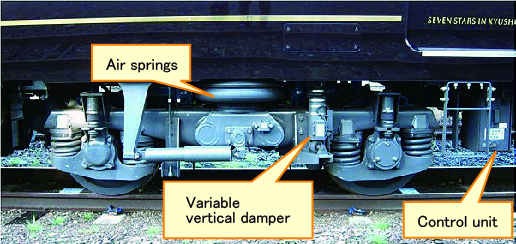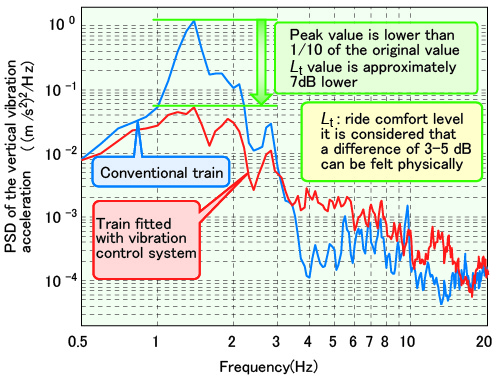1. Vertical vibration control system for practical use on bolsterless air spring bogies
- A vertical vibration control system was developed for bolsterless air spring bogies.
- It was confirmed that this system can reduce the power of carbody vertical acceleration by up to 90%.
- Applied in practice to a cruise train, ride comfort was demonstrably improved.
Luxury, or "Cruise Trains" are expected to offer optimal ride comfort regardless of where it is running. When this type of train operates along regional lines where continuous long welded rails are not always used, vertical vibration of the carbody increases when running over rail joints, which may reduce ride comfort considerably. As such, in order to provide the best possible ride comfort along this type of section, a system was developed to reduce vertical vibrations on bolsterless air spring bogies.
A variable vertical hydraulic damper was mounted in parallel to the air springs (Fig.1). The damping force is controlled to adjust to carbody vibrations, thereby controlling overall vibration. Compared with similar devices already designed for bogies equipped with coil springs, the present system softens the jerkiness which can be felt as the control operates, thanks to improved control of the damping force in relation to the command current and better mastery over sending the command value. The system helps to reduce rigid body vibrations as well as elastic vibration.
Running tests were carried out to validate the vibration reduction performance of the device. Results showed that the developed system was suitable for practical implementation and in addition, when used with soft air springs the peak value of the PSD of vertical vibration acceleration in the region of 1-2 Hz was cut to 1/10 of what it was previously demonstrating its effectiveness in bringing down vibration levels, compared with conventional cars (Fig.2). The ride comfort level (LT) was reduced by approximately 7dB which means that there the improvement in ride comfort can be felt physically.
This system was introduced into operation on all passenger cars on the JR Kyushu "Nanatsuboshi in Kyushu" Cruise Trains in October 2013, and has since then contributed to improving the ride comfort of passengers using this service.

Fig.1 Picture of fitted device
(on the Seven Stars cruise Train “Nanatsuboshi” in Kyushu)
Fig.2 Comparison of vertical vibration on conventional train
and train fitted with the new device
(running speed of 60 km/h)